
To achieve a successful straight razor shave, start by gathering your supplies, including a quality razor and strop. Clean your face with warm water, then apply pre-shave oil or lotion for moisturizing. Soften your hair with a warm towel and lather up using a quality shaving cream. Maintain a 30-degree blade angle while shaving with short strokes, applying gentle pressure. Rinse the blade often and cleanse your face with cool water after shaving. Finally, moisturize with an aftershave balm. Master these steps for optimal results, and there's plenty more to explore for perfecting your technique.
Key Takeaways
- Gather all necessary supplies including a straight razor, strop, shaving brush, cream, and a well-lit mirror for clear visibility.
- Prepare your skin by washing your face with warm water and applying pre-shave oil or lotion to minimize irritation.
- Soften the hair using a warm towel and apply high-quality shaving cream, working it into the beard for better lift.
- Hone the blade using the correct stone and technique; maintain a 20-degree angle for effective sharpening and regular maintenance.
- After shaving, rinse the blade, splash your face with cool water, and apply aftershave balm to soothe the skin and lock in moisture.
Gather Your Supplies
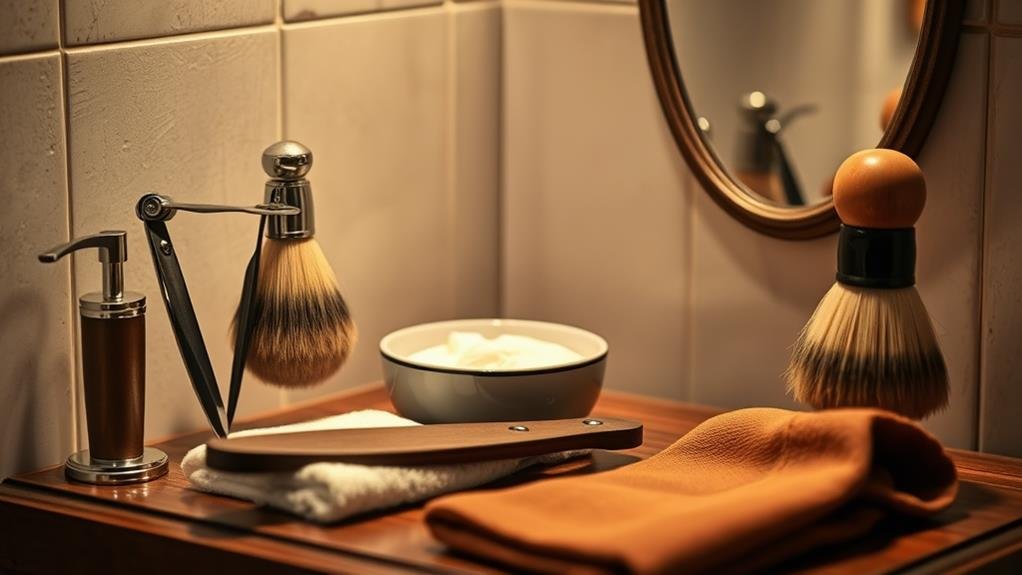
To begin your straight razor shaving journey, you'll need to gather essential supplies that ensure a smooth and safe experience. First, invest in a high-quality straight razor; look for one that feels comfortable in your hand and has a well-maintained blade. The historical significance of straight razors dates back centuries, symbolizing craftsmanship and personal grooming mastery.
Next, consider a strop for maintaining your razor's edge. Regular stropping is crucial for optimal performance, enhancing your shaving experience.
You'll also need a shaving brush and high-quality shaving soap or cream. A brush helps create a rich lather, enabling the blade to glide effortlessly over your skin.
Safety precautions are paramount in this process. Always keep your razor dry and stored securely when not in use. A leather or wooden case can shield it from damage and maintain its condition.
Additionally, a small bowl for water and a mirror with good lighting will facilitate a clear view while shaving.
Prepare Your Skin
After gathering your supplies, the next step involves preparing your skin for a smooth shave. A solid pre shave routine is crucial to achieving the best results with a straight razor.
Start by washing your face with warm water to remove dirt and oil; this helps to open up your pores.
Next, focus on skin hydration. Apply a pre-shave oil or lotion to ensure your skin is adequately moisturized. This not only softens the skin but also creates a protective barrier, minimizing the risk of irritation during shaving.
Allow the product to absorb for a minute or two; this enhances its effectiveness.
If you have sensitive skin, consider using a product with calming ingredients like aloe vera or chamomile. This will soothe your skin and reduce any potential redness.
Lastly, don't rush this step. Take your time to thoroughly prepare your skin; the better the preparation, the smoother the shave.
Once your skin is hydrated and ready, you'll be set for the next step of softening your hair, which is equally essential for a successful straight razor shave.
Soften the Hair
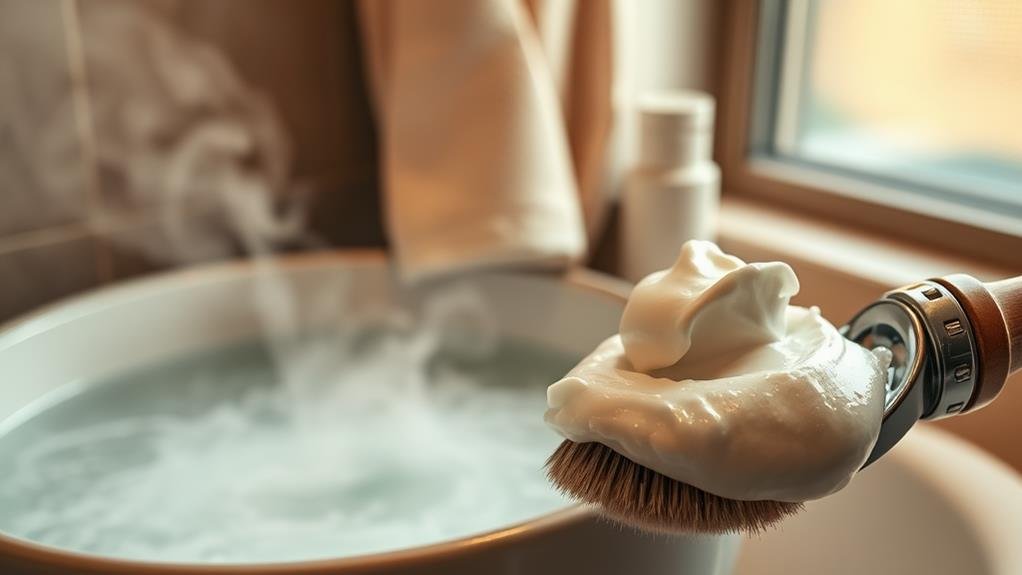
Soften the hair for a smoother shaving experience by applying a warm, damp towel to your face. This initial step opens your pores and relaxes the hair follicles, making it easier for the razor to glide over your skin. Leave the towel on for about two to three minutes, ensuring that the warmth penetrates effectively.
Next, choose a high-quality shaving cream tailored to your specific hair type. Whether you have coarse, fine, or curly hair, using the right product can significantly enhance your shaving experience.
For thicker hair types, look for creams with added moisturizers; they help soften the hair further, reducing the risk of irritation. If your hair is fine, lighter creams will suffice and provide a smooth glide.
After applying the shaving cream, work it into your beard with your fingers or a brush to create a lather. This not only helps soften the hair even more but also lifts it away from the skin for a closer shave.
Hone the Blade
To achieve a sharp edge on your straight razor, you need to choose the right honing stone.
Understanding proper honing techniques is crucial for maintaining the blade's effectiveness and longevity.
Choosing the Right Stone
When it comes to honing your straight razor, selecting the right stone is crucial for achieving a sharp, durable edge. The choice of stone directly influences your sharpening techniques and the overall performance of your blade.
There are several stone types to consider, each with unique properties that affect the honing process. Natural stones, like Arkansas or Japanese water stones, offer excellent results due to their natural abrasiveness. Synthetic stones, such as diamond plates or ceramic hones, provide consistent grit levels and durability.
When choosing a stone, consider the grit rating. Coarse grits (around 220-1000) are ideal for reshaping and repairing an edge, while medium (1000-3000) and fine grits (4000-8000) refine the edge for a smooth shave.
It's also important to think about the size and flatness of the stone. A larger surface area allows for easier honing, while a flat stone ensures consistent contact with the blade.
Keep in mind that investing in quality stones will enhance your overall shaving experience. With the right stone, you'll master the art of honing and enjoy the benefits of a well-maintained straight razor.
Proper Honing Technique
Having selected the right honing stone, you can now focus on the proper honing technique to sharpen your straight razor effectively.
Start by ensuring your stone is flat and well-lubricated with water or honing oil, depending on the type of stone you're using. Hold the blade at a 20-degree angle against the stone, applying light pressure. Use smooth, controlled strokes, moving the blade away from you, as if you're slicing the stone.
Engage in a consistent back-and-forth motion, alternating sides of the blade to ensure even sharpening. This method is one of the most effective sharpening techniques for maintaining a keen edge.
After several passes, check the blade for sharpness by gently running your thumb along the edge—never across it. You should feel a slight bite if the blade is adequately honed.
Regular blade maintenance is crucial. Hone your razor every few uses to prevent dullness, and consider using a finer grit stone for finishing.
Lather Up Properly
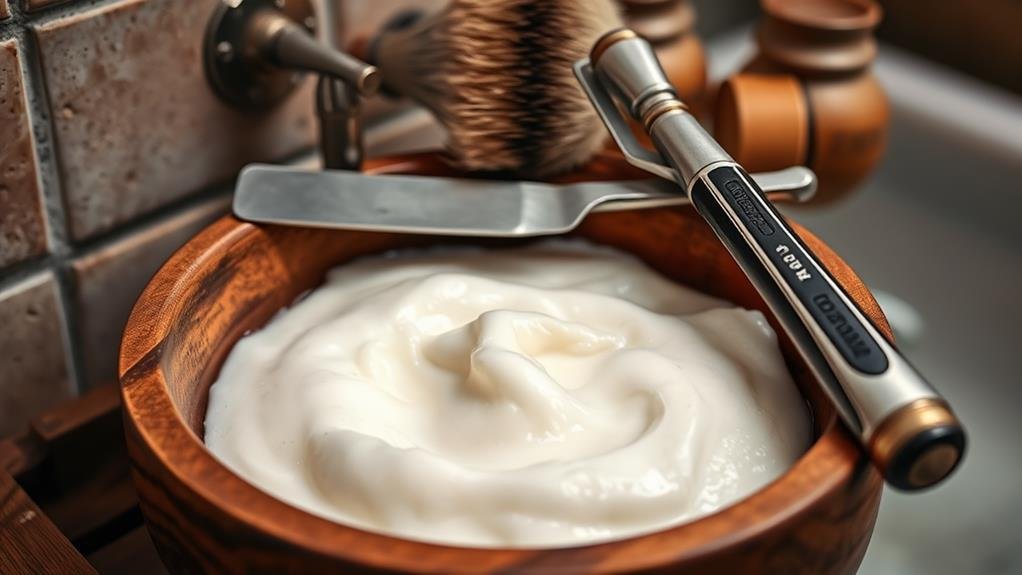
Achieving a rich, creamy lather is crucial for an effective straight razor shave. Start by selecting high-quality shaving products, such as creams or soaps designed specifically for straight razor use. These products vary in lather types, including glycerin-based, tallow-based, or vegan options, each providing unique benefits.
To create the perfect lather, use a shaving brush. Wet the brush with warm water, then load it with your chosen product by swirling the brush in the container. This incorporates air into the mix, which is essential for a voluminous lather.
Next, transfer the loaded brush to a bowl or directly onto your face. Add small amounts of water as needed while you whip the lather into a frothy consistency. Aim for a texture that's thick yet spreadable, allowing it to cling to your skin and hair.
Once you've achieved the desired lather, apply it generously to your face, ensuring even coverage. This not only hydrates the hair for a smoother cut but also protects your skin from irritation.
A well-lathered face sets the stage for a precise and comfortable straight razor shave.
Master Your Grip
Your grip on the straight razor plays a vital role in ensuring a safe and effective shave. Mastering grip techniques is essential for maintaining control and minimizing the risk of cuts. Start by holding the razor with your dominant hand, positioning your thumb on the tang and wrapping your fingers around the handle. This hand positioning allows for maximum leverage and stability, giving you confidence as you navigate the contours of your face.
Consider employing a thumb-over grip, where your thumb rests on the spine of the blade. This method enhances precision, particularly when maneuvering around delicate areas. Alternatively, the thumb-under grip can provide extra control when working along the jawline. Whichever technique you choose, ensure your grip is firm but not overly tight—too much tension can lead to fatigue and compromise your technique.
As you practice, pay attention to how your hand positioning affects your shaving angle and comfort level. Developing a relaxed yet purposeful grip will empower you to master the straight razor, allowing for a seamless and liberating shaving experience.
Find the Right Angle
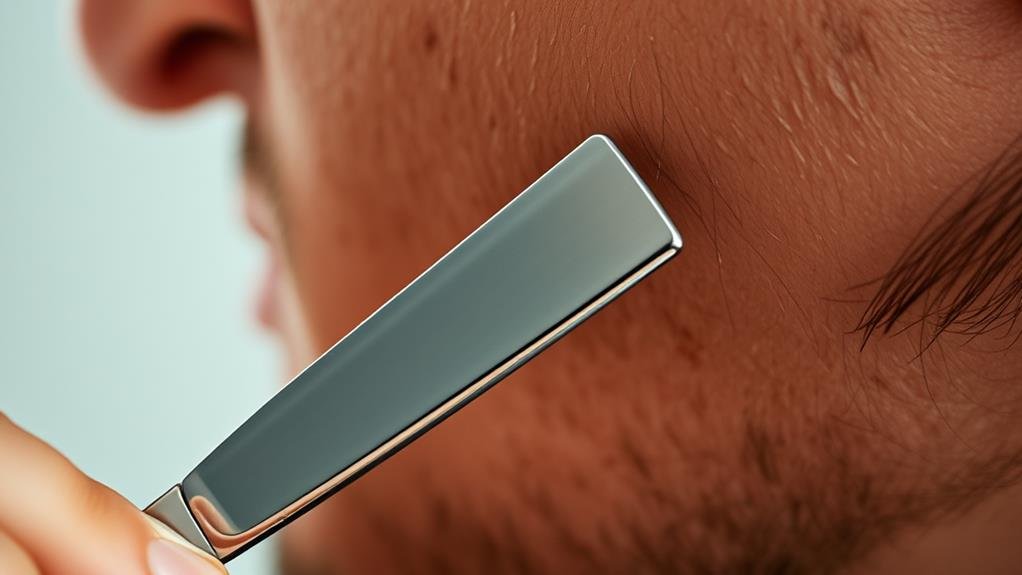
Finding the right angle is crucial for a successful straight razor shave. You want to position the blade at approximately a 30-degree angle against your skin. This angle ensures optimal blade alignment, allowing the razor to glide smoothly while effectively cutting hair. If the angle is too steep, you risk nicking yourself or causing irritation; too shallow, and you won't achieve a close shave.
To maintain this angle, tilt the razor slightly away from your face as you move it in short, controlled strokes. Pay close attention to your shaving pressure; you should let the weight of the razor do most of the work. Pressing too hard can compromise both blade alignment and your skin's integrity, leading to cuts or razor burn.
Start with the grain of your hair growth and adjust your angle as needed for different areas of your face. Experimentation is key — find what feels comfortable and effective for you.
Shave With Care
Once you've nailed the right angle, the next step is to shave with care. This means applying the correct shaving techniques to ensure a smooth and irritation-free experience. Always remember to use gentle pressure; let the razor do the work. Avoid pressing too hard, as this can lead to nicks and cuts.
When you're ready to begin, take your time. Start with the grain of your hair growth, using short, controlled strokes. This helps in minimizing irritation and enhances your skin care routine. If you need to go against the grain for a closer shave, make sure your skin is taut to avoid pulling.
Here's a quick reference table for proper shaving techniques:
| Technique | Description |
|---|---|
| Angle | Maintain a 30-degree angle for optimal results. |
| Pressure | Use light pressure to avoid cuts and irritation. |
| Stroke Length | Use short strokes to maintain control and precision. |
| Skin Tautness | Pull skin taut to prevent pulling and irritation. |
Rinse and Clean
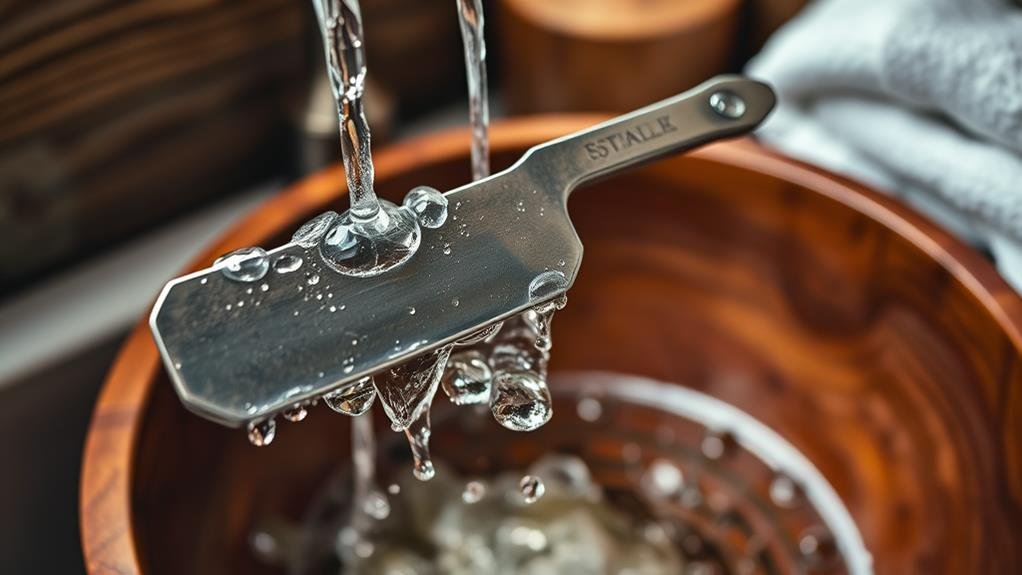
Achieving a clean and refreshing finish is crucial after shaving, and rinsing the blade properly is an essential part of this process. Start by rinsing your straight razor under warm running water. This helps remove hair, shaving cream, and any residue that may have accumulated during your shave. Ensure you rinse both sides of the blade thoroughly to maintain its integrity and sharpness.
Next, don't forget about your skin. After rinsing the blade, it's time for your post shave care routine. Gently splash your face with cool water to close your pores and enhance skin hydration. This step is vital in preventing irritation and promoting a smooth complexion.
After rinsing, pat your face dry with a clean towel, avoiding any aggressive rubbing. You want to preserve that delicate moisture balance.
Following this, apply a quality aftershave balm or moisturizer suited to your skin type. This won't only soothe any potential irritation but also lock in hydration, ensuring your skin feels soft and refreshed.
Maintain Your Razor
After completing your post-shave routine, the next step is to maintain your razor for optimal performance and longevity. Proper care ensures your blade remains sharp and effective, enhancing your shaving experience.
Begin by storing your razor correctly. Keep it in a dry place, away from moisture, which can lead to rust. A dedicated razor case or a leather pouch is ideal for razor storage.
Next, regularly inspect your blade. Look for any signs of wear or damage. A well-maintained blade can last longer, offering improved comfort and precision during shaves.
Here's a quick reference table for maintaining your razor:
| Task | Frequency | Benefits |
|---|---|---|
| Clean the blade | After each use | Prevents rust and buildup |
| Strop the blade | Before each use | Enhances sharpness and blade longevity |
| Inspect for damage | Weekly | Ensures safety and performance |
| Store properly | Always | Protects from moisture and damage |
| Replace when needed | As required | Ensures optimal shaving experience |
Following these guidelines will help you maintain your razor effectively, ensuring it remains a reliable tool for years to come.
Conclusion
You've now mastered the essential steps for straight razor shaving. Remember, "the devil's in the details," so take your time with each stage to ensure a smooth, irritation-free shave. By gathering your supplies, prepping your skin, and maintaining your razor, you'll not only achieve a close shave but also elevate your grooming routine. With practice, you'll gain confidence and skill, turning this art into a daily ritual that you truly enjoy. Happy shaving!
